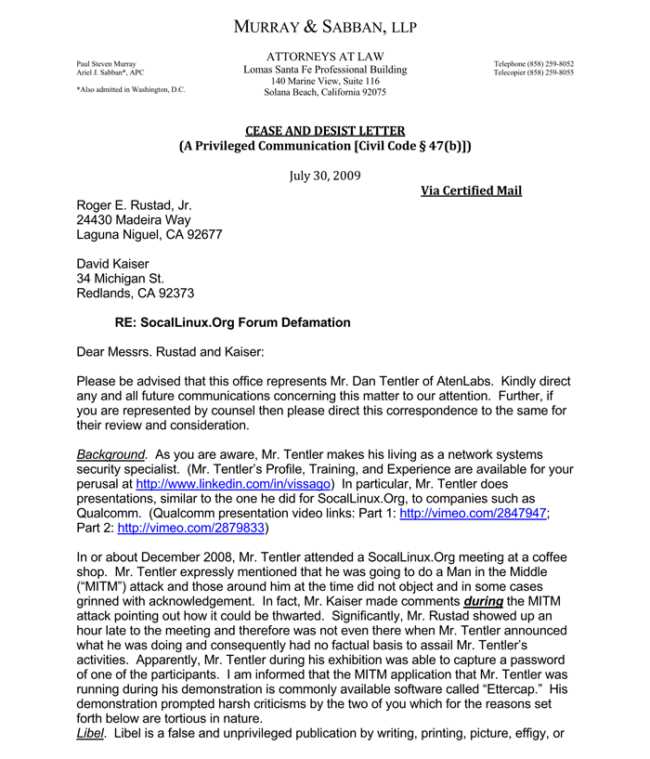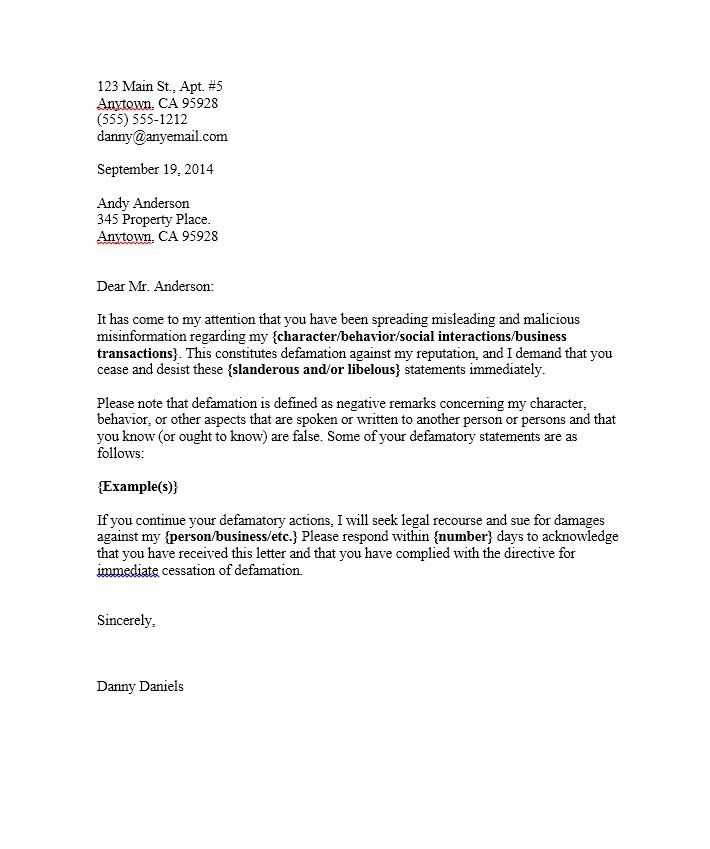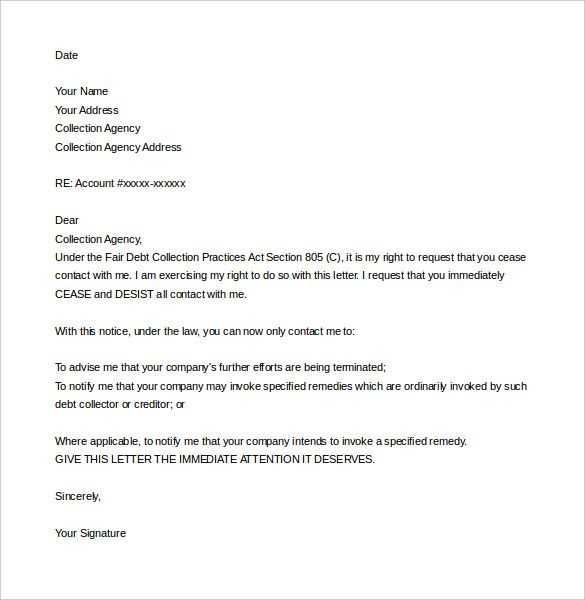Cease and Desist Letter Template for Defamation of Character

When someone makes false statements that harm your reputation, it can be a frustrating and damaging experience. Legal steps can be taken to address such situations and protect your personal or professional image. One of the first courses of action is to formally request that the individual cease their harmful actions.
Creating a well-structured document outlining the wrongdoer’s actions and the legal consequences they may face can often be enough to resolve the issue without further escalation. This kind of formal communication serves as a warning and can lead to the cessation of harmful behaviors before more serious legal proceedings are necessary.
In this guide, we’ll explore how to construct a proper notification that can help you address the situation effectively. With the right approach, you can assert your rights, ensure the issue is understood, and take the appropriate steps to safeguard your reputation.
What is a Cease and Desist Letter?
When someone engages in behavior that harms your reputation or infringes upon your rights, a formal request can be made for them to stop their actions immediately. This type of communication is often used to address violations without resorting to litigation. It acts as a clear warning to the offending party that their actions are unlawful and must be halted.
The purpose of this document is to inform the individual that they are engaging in illegal conduct and to demand that they discontinue it. The communication typically outlines the specific behavior, explains why it is harmful or unlawful, and specifies the actions the recipient must take to avoid further legal consequences.
Such a notification can be an effective tool for resolving disputes before they escalate into more serious legal issues. By addressing the problem early, it allows the wrongdoer a chance to correct their actions without the need for a court case or more severe measures.
Why Use a Defamation Letter?

When an individual spreads false information about you, it can significantly impact your personal or professional life. Taking immediate action is essential to stop the harm and protect your reputation. One way to address this issue is by issuing a formal request demanding the other party to halt their actions.
Prevent Further Damage
By sending a formal communication, you can take swift action to prevent the situation from escalating. The letter not only warns the individual about the consequences of their behavior but also gives them an opportunity to rectify their mistake before any legal proceedings begin. This approach can minimize the damage caused by the harmful statements.
Protect Your Reputation
Your reputation is a valuable asset, and any false claims can severely affect your personal or business relationships. Sending a written demand to stop harmful actions demonstrates your seriousness about protecting your good name and can serve as an initial step in preserving your integrity without resorting to lengthy court battles.
Key Components of a Legal Letter

A well-crafted document aimed at stopping harmful behavior must be clear, concise, and legally sound. It should include all the necessary information to ensure the recipient understands the severity of the situation and the potential consequences of their actions. Each section of the communication plays an important role in addressing the issue effectively.
First, the letter must identify both parties involved, providing full names and contact details to avoid any confusion. Then, it is essential to explain the unlawful conduct that has taken place, outlining specific instances where the individual’s actions caused harm. Following this, the document should demand the cessation of the harmful behavior, stating a clear deadline for compliance.
Lastly, the communication must include a warning of potential legal actions if the recipient fails to comply. This serves as a final notice before pursuing further steps. By incorporating these key elements, you ensure the message is not only professional but also legally binding and enforceable if necessary.
Steps to Create a Defamation Template
Creating a structured document to address harmful statements involves several key steps. It’s crucial to craft a message that is clear, firm, and professional, ensuring it covers all the necessary details while maintaining a respectful tone. Following a proper process will increase the likelihood of resolving the issue swiftly without legal escalation.
The first step is to clearly identify the individual or entity that made the false statements. Gather all the relevant details, including the date, location, and the content of the harmful remarks. This will help create a factual account of the situation, leaving no room for misinterpretation.
Next, outline the specific actions you are requesting. Clearly state that the individual must cease the harmful behavior immediately. Provide a reasonable timeframe for compliance, as this demonstrates your willingness to resolve the matter amicably.
Lastly, ensure the document includes a warning about possible legal consequences if the behavior continues. This will make the recipient aware of the seriousness of the issue and motivate them to act accordingly. By following these steps, you create an effective document that serves as both a formal request and a warning.
How to Send a Cease and Desist Notice
Once you have drafted your formal request to stop harmful actions, the next step is to send it to the offending party. The method of delivery is essential to ensure that the recipient receives the communication and is fully aware of the consequences of their actions. It’s important to choose a delivery method that provides proof of receipt, such as certified mail or other verifiable services.
Below is a table outlining common methods for sending a formal notice and their respective benefits:
| Method | Advantages |
|---|---|
| Certified Mail | Provides proof of delivery and receipt. Legal evidence if needed. |
| Fast and cost-effective. Ensure read receipt confirmation is enabled. | |
| Personal Delivery | Immediate delivery, ensures recipient personally receives the notice. |
| Courier Service | Fast delivery with tracking and confirmation of receipt. |
After sending the communication, keep copies of all correspondence and proof of delivery. This documentation may be needed in case further action is required. Ensure that you are respectful and professional throughout the process, as this may influence how the situation is resolved moving forward.
Legal Considerations and Risks Involved
When addressing harmful behavior through formal communication, it is important to consider the potential legal implications and risks involved. While such actions are often effective in resolving disputes, improper handling could lead to unintended consequences. Being aware of these risks is crucial to ensure that your rights are protected and that the process is conducted lawfully.
Here are some key legal considerations to keep in mind:
- False Claims: If you make incorrect accusations or misrepresent facts, you could be subject to a defamation claim yourself. Make sure the information you include is accurate and verifiable.
- Overly Aggressive Language: While it’s important to be firm, using threatening or harsh language may provoke further conflict or be seen as harassment. Maintaining professionalism is key.
- Potential Legal Action: If the recipient refuses to comply, it may be necessary to pursue further legal action. Be prepared for the possibility of a lawsuit, and ensure you have legal grounds to back your claims.
Additionally, there are risks associated with not following proper procedures, which could undermine your case. If your communication is not clear or legally sound, it may be dismissed in court if the matter escalates. It’s wise to consult with a legal professional before sending any formal notice to ensure your rights are fully protected.
Ultimately, taking the time to understand the risks and handle the situation carefully will help you avoid complications and improve the chances of a successful resolution.